Kohli's cabbage in our latitudes was distributed relatively recently, it is mainly growing gardens in garden sites. Kolrabi is a valuable dietary product that can be eaten in cheese, stew or boiled form. Thanks to the unpretentiousness of this vegetable plant, grow it on its plot and get plentiful harvest is easy.
What is Kohlrabi
This type of garden cabbage is like a family of the Mediterranean, it is cultivated since the time of ancient Rome. In the XVI century, the German peasants were engaged in the cultivation of Kohlrab cabbage, in the future she was widespread in Europe and Asia.
With its title, which means "Cabbage-Rope", Kohlrabi is obliged to edible steering-shaped stem forming from a thickened stem. Due to the presence of a complex of mineral substances (magnesium, iron and calcium), vitamins of the group B, as well as a significant amount of ascorbic acid, this type of cabbage is rightly called "Northern Lemon". The pulp of its stem has excellent taste characteristics, it contains vegetable protein, useful fiber, pectins, glucose and fructose. With the use of Kohlrabi, the activity of the heart and blood vessels is normalized, in addition, this product has the ability to reduce the pressure and the amount of harmful cholesterol in the blood, is characterized by a light diuretic effect and gently purifies the intestines from the accumulated slags. Due to the significant content of calcium (three times more than the other types of cabbage), Kohlrabi should use children, pregnant women and older people. In addition, this stem is low calorie and is a dietary product that helps reduce weight.
It is worth noting that in case of diseases of the gastrointestinal tract with increased acidity of the gastric juice, this stem is not recommended in significant quantities. It is known that cabbage repa under certain conditions can accumulate nitrates. If you are planning to grow and care for Kohlrabi on your site, only you decide whether chemical fertilizers apply, or it is better to do a purely organic feeding.
Kohlrabi cabbage varieties
This two-year vegetable plant is frost-resistant, early and unpretentious. Such cabbage has a branched root system capable of delving into the soil up to 2 m. As a rule, 2-3 months after the Kollarbi landing can already be collected a full-fledged harvest. In the first year of the vegetation, a cabbage "turnip" is formed, for the second year - a long escape with flowers, and then with fruits in the form of pods. Stems such a cabbage can be a light green, yellow-green or blue-violet shade. Sorts with white (more precisely, light green) fruits are usually characterized by particularly high rapidness. Kohlrabi varieties with pebbles of purple color are used for autumn-summer cultivation, as they grow slowly, not disturbing and almost not a country. Such plants need to plant no later than the beginning of July, then the harvest collected in October can be eaten in autumn and winter.
The cabbage "repa" grows by a rounded, a flat round or egg-shaped. Depending on the variety, the weight of the fruits can be from 90-200 g (Athine, Vienna White) to several kilograms (Moravia, Violetta). The Czech giant is characterized by large stagpiplodes, reaching 6 kg in some cases. Separate late varieties and hybrids can form steblacks for quite a long time - up to 4-5 months, such a crop can be prepared in autumn for long-term storage.
How to grow Kohlrabi
This plant is not too demanding to climate, the conditions of cultivation and care - Kohlrabi cabbage can be successfully cultivated on various types of soil. Nevertheless, it is best formed fertile, well-humidated soil with a sufficient amount of organic matter. The plot for the planned landing from the fall is recommended to be made, it is also advisable to make feeding to the soil in the form of humus.
Kohlrabi cabbage can be grown from seedlings or disembarking seeds into open ground. This plant is distinguished by cold resistance, as it is capable of withstanding not long-term freezing. Nevertheless, it is worth considering that long-term (more than 3-4 days) supercooling at temperatures below 7-8 ° C can provoke the development of the arrows and negatively affect the fruiting of the kale "turnips", the same can happen with an overgrown seedliness. With an early landing, in case of unfavorable weather conditions, the plants are recommended to cover the nonwoven cannol to avoid hypothermia.
Thanks to a short vegetation period for the year, you can collect 2-3 Kohllabi yield - for this immediately after cleaning the hasty stebleplodes, you can plant a new seedlings. Potatoes, legumes, cucumbers, and onions, carrots and siters can be played as friendly predecessors of Kohlrabi. It is not recommended to plant this plant on the site, where it has grown cabbage, salad, trouser, tomatoes, radishes and beets. It is worth considering that Kohlrabi can be planted on the same plot no earlier than 4 years. Quite often, this plant is planted between the beds with late varieties of white cabbage, cucumbers or tomatoes, as well as after harvesting the early greenery - feathers, spinach or salad.
Although this plant loves moisture, in most cases it can be transferred short-term drought, as it has an extensive and in-depth root system. This type of cabbage is light-chapter (especially early varieties), so it will take to pick up a bed with good illumination. Late varieties of Kohlrabi are well tolerated partial shading. Planting into the open ground seeds of this plant or seedlings should be in the second half of spring, starting from the end of April. When landing, you can make mineral fertilizers at the rate of 2 tbsp. phosphate, 1 tsp. urea, as well as 2-3 tbsp. Ash to one hole, thoroughly mixing them with soil.
Before disembarking, you will need to prepare seeds. To do this, it is necessary to immerse them in hot water (with a temperature of about 50 ° C) by a quarter of an hour, then in the cold one minute. After that, they should be soaked them in a pale pink solution of manganese or organic solution for several hours, and then put on a 24-hour refrigerator.
Growing seedlings
As well as for white cabbage, the early fall of Kohlby seeds in the seedlings, greenhouses or greenhouses are performed in the middle of March (optimally in a mixture of soil, sand, humid and peat). The soil mixture will be required to regularly water the room temperature. After shootings appear, the air temperature should be reduced to +8 ° C. When the first full-fledged leaves appear in the seedlings, plants should be kept in plastic cups with peat mixture (in front of this, seedlings should be poured by a pale manganese solution).
After the appearance of two sheets, it is possible to carry out a non-rootful feeder. To do this, it will be necessary to dilute in 1 liter of water 0.5 C.L. Mineral complex fertilizer and spray the leaves of Kohlrabi given solution. 15 days before the disembarkation should be started to tempt the seedlings by moving it in the afternoon on the balcony or to a greenhouse with a temperature around +5 ° C (at night there should be plants in a warmer place with a temperature of about +10 ° C). Before hardening, you can implement another feeding - for this it will be necessary to clean the leafs with a solution of urea and potassium sulfate (1 tbsp. On the water bucket). All seedlings will need to be treated with such a feeding - at the rate of 150 ml of solution for each plant.
A week before landing in open ground, it is necessary to stop watering seedlings. Approximately by the beginning of May, 4-6 leaves will appear on each plant, and the seedlings will need to be abundantly pouring in the cups and land at a permanent place of growth in open ground. When landing, the distance between the rows of about 50 cm should be observed, between the plants - depending on the variety, up to 25 cm. Estimated varieties that are distinguished by small stems and the rosette of the leaves, can be planted more boring.
It is worth considering that during a thickened landing to grow abundant harvest with large fruits is unlikely to succeed. Thus, on 1 m 2 you can accommodate up to 10 plants. Seedlings of seedlings should be plugged into the ground, not reaching the cotyledon, otherwise the development of steblepodes will be largely slow or will replace its bloom.
Planting seeds in open ground
When growing kollarbi from seeds, it is necessary to place them in the open ground at a depth of 1.5-2 cm, so that they are literally slightly sprinkled with the earth. In this case, the plant will not be too shredded, and it will have conditions for the full development of a large and juicy stubble. In addition, when planting seeds, it is necessary to observe the width of the rod of about 0.5 m, while the distance between the plants should be about 4 cm.
After germination of the seeds, the beds with Kohlrab should be switched, so that the adjacent sprouts were located with a frequency of 7-8 cm. When the leaves are started to climb, it will be necessary to make one more breaking, leaving between the plants of the gaps of about 20 cm. Sedisted seedlings should not be thrown away, They can be planted on another bed.
Plant care
For Kohlrabi, it is necessary to be simple, but quite regular care in the form of a weeding of beds from weeds and systematic loosenings, as well as not too abundant, but frequent irrigation (at least once a week). To create optimal conditions for the development of the fruits of this type of cabbage, it is necessary to maintain the soil in a permanently moistened state.
It is worth considering that in the event of a lack of moisture, the Kohlrabi stalk loses flavoring qualities, become rigid and fibrous, as well as crack. Nevertheless, it is not worth the oveurgement of the soil. After each irrigation, it is necessary to thoroughly break the soil to a depth of 7-8 cm. If after 3 weeks after landing, and then after another 20 days there is a dipping of plants, then the fruits will stretch up and get a cylindrical shape. It should be noted that Kohlrabi may be subject to attacks of a cruciferous flew, as well as a black leg. To combat pests, as well as as feeding plants, it will be necessary to sprinkle sawing wood asset (at the rate of 1 glass per 1 m 2).
With the appearance of 7-8 leaves, the formation of Kohlrabi steblablodes begins. Next, you will need to track the degree of their maturity. Cleaning the harvest must be carried out in a timely manner, as the overwhelmed fruits acquire rigidity. Early grades can give a harvest from the beginning of June (it will be necessary to remove it by achieving with stovels of diameter of 8-10 cm). Late fruit in October - in this case, the fruits should be removed before frosts, otherwise their tasteings will suffer.
To assemble the harvest, it is necessary to dig the plants of Kohlrabi with roots. After that, the roots and leaves are cut off, leaving the stiffs with a length of about 1-2 cm. Such a crop can be placed on storage in a dry ventilated basement, moving with wet sand. The best collar is stored at a temperature of about 0-1 ° C. Dried and peeled fruit fruits folded into the refrigerator will retain taste, elasticity and freshness for several weeks.


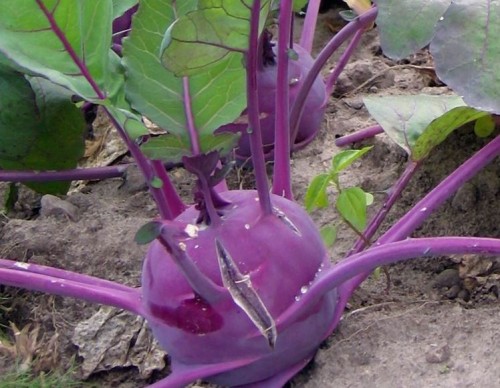
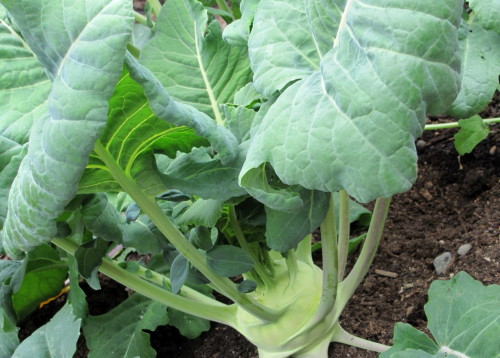
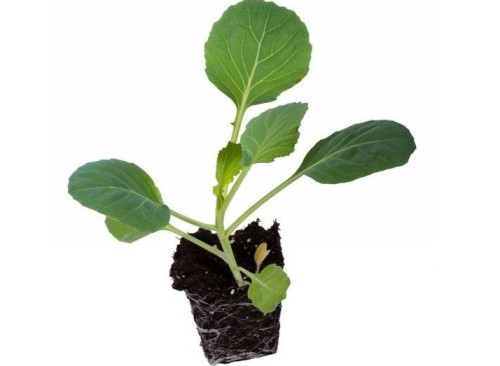
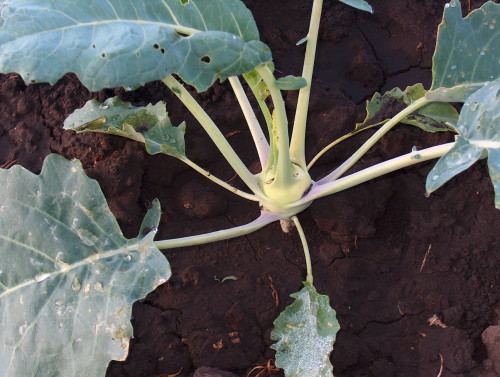
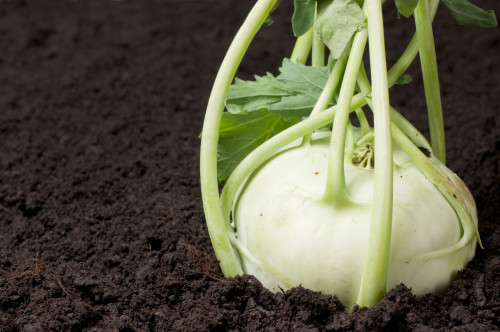

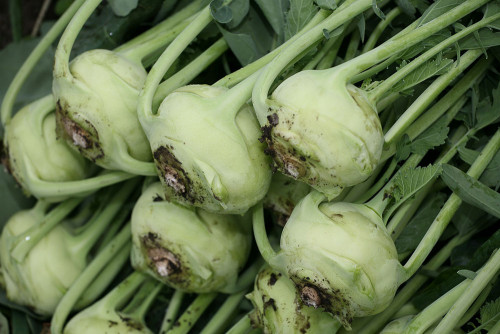
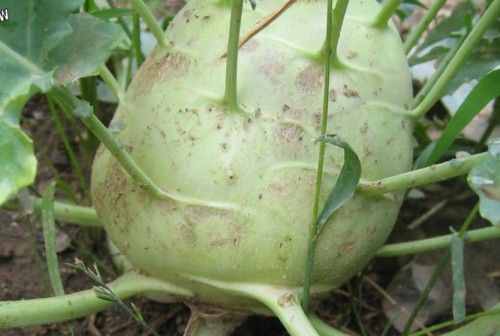












 Start a discussion ...
Start a discussion ...